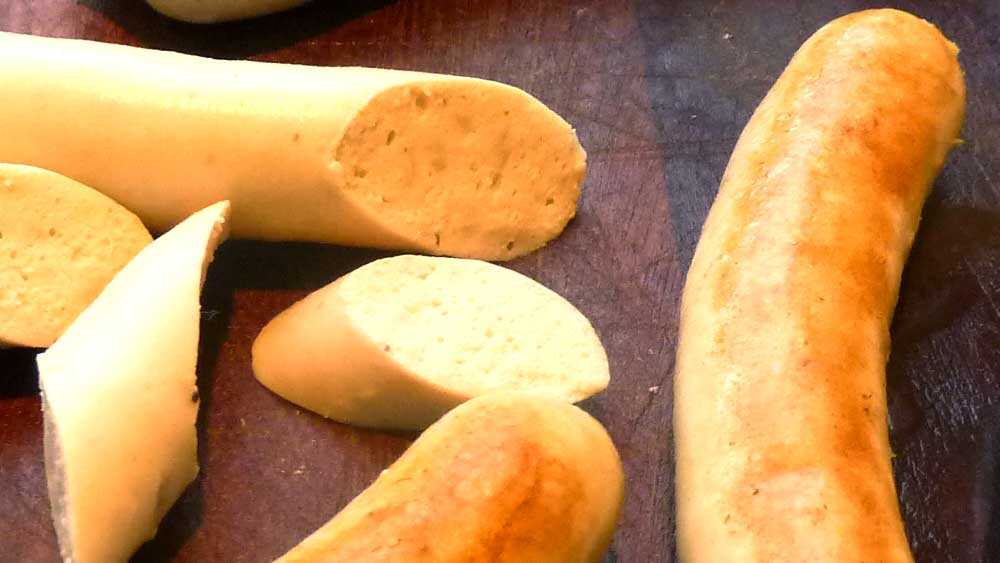
This is the recipe for a chicken sausage totally homemade Natural, free from chemical additives, preservatives, colorings, stabilizers or industrial emulsifiers. Starting from this base recipe, you can add whatever condiments you want. The most important thing is to master the basic process of making sausage, which is what I intend to go through in this recipe.
What is a sausage?
All sausage is what is commonly called a meat emulsion or, in more detail, a uniform, stabilized mixture of water, fat and protein. The stability of this mixture depends on a good source of protein and low temperature. Powdered milk also helps to bind the dough together. If the temperature rises during preparation, the fat will melt and the emulsion will come apart. The skin can also be used as it is a great “binder”. Industrial sausages use a lot of skin, stabilizing and emulsifying additives as they overuse water and CMS (“Mechanically Separated “Meat”), which is a poor source of protein. To learn more about Brazilian legislation on sausages, see the post What is sausage made of?
Using domestic equipment it is very difficult to achieve a completely smooth dough, without grains, but with reasonable equipment and a dose of patience it is possible to get close to it. Don't be afraid to stop the process, cool the dough again and continue processing later. The biggest difficulty is the temperature, as domestic processors heat the sausage dough a lot, which is dense and requires a lot of equipment.
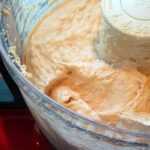
More traditional recipes usually use between 20% and 30% of fat in the product, that is, for 800g of meat they add approximately 200g of additional fat. I didn't add fat, I just used what was already in the thigh and skin. If you use chicken breast, you will need to add an extra source of fat.
Ingredients
- Chicken thigh – 1050g
- Vegetable Broth – 450ml
- Salt – 15g
- Sugar – 12g
- Paprika – 1g
- White pepper – 2g
- Powdered milk – 2 tablespoons
- Lamb tripe or collagen casing thin – 2m
The ideal is to use sheep intestine as it is thinner and more delicate than pork intestine. If you choose artificial casings, you can use low-caliber collagen casings or cellulose casings, which are inedible and must be removed after cooking. Supermarket sausages are usually cooked in cellulose casings that are removed after cooking.
Equipment removing casing from cooked sausages
Method of preparation
Grind and make homemade chicken sausage meat emulsion
- Season the meat the day before, add all the ingredients except the powdered milk and vegetable broth;
- Leave the vegetable broth very cold or freeze it and chop it very finely, like crushed ice;
- Remove and reserve the skin from the thighs;
- Remove the bone and cartilage while preserving the existing fat;
- Optional: Pass the meat and skin through the grinder with the wide disc and place in the freezer for a few minutes to cool again;
- Place the meat in the food processor fitted with the cutting knife and start processing on high power;
- Add the powdered milk and continue processing;
- Gradually add the well-chilled or frozen and chopped broth. It is important to add it little by little to cool the dough during processing;
- Measure the temperature constantly and if it exceeds 15 degrees, take it immediately to the freezer and wait a few minutes for the temperature of the dough to reduce;
- Continue processing until the mixture is smooth, homogeneous, with the appearance and consistency of a paste. The smoother the better;
- If the consistency of the dough is too dense, add more liquid, which can be very cold water or crushed ice.
Insert and cook the sausage
- Fill the casing with the dough, roll it up or tie it with string every 10 or 15 centimeters;
- Cook in water heated between 75ºC and 80ºC for around 20 minutes;
- Fry on a griddle or frying pan with a little olive oil.
Watch the video to see a summary of the production of natural chicken sausage.




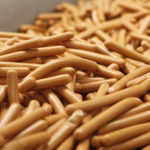
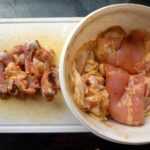
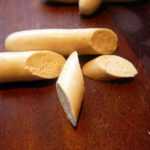
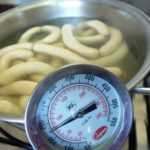

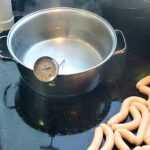

What is the vegetable broth like and how much?
Thank you very much for your attention
You can cook some vegetables to your liking, such as garlic, ceola, carrots, rosemary, etc., in water or use a ready-made vegetable broth. If you are using the ready-made one, reduce the salt in the recipe a little to compensate for the salt in the ready-made broth.
Good afternoon! How much water do I have to use to make this vegetable broth and can I replace it with beetroot juice to make it more colorful?
Yes, you can use beetroot, it will help with the color. Regarding the amount of water, I can't say, I made the broth without measurements as it replaced the water/ice that is usually added to mortadella.
Thank you very much for sharing your knowledge.
Excellent recipe! Thanks so much for sharing!
When I cook my sausages, they burst! can you tell me why? and how do I stop it from exploding?
Hi Andre, you are probably making a very common mistake. The sausage must be heated in hot water, never boiling. The sausage we buy in the supermarket is pre-cooked and only needs to be heated before consumption. When it boils, it bursts because the internal moisture evaporates, expands and “bursts” the product. Proceed like this: boil the water, turn off the heat, add the sausages, count 5 minutes, ready to eat!
If you are producing the sausage at home, you will need to cook them, but even then you will have to cook them in water heated between 75ºC and 80ºC for around 20 minutes.
If you make your own sausage, do I always need to keep the temperature at the temperature you indicated when cooking? To do this, may it be necessary to turn the heat on and off?
You must always keep the water close to the recommended temperature to cook correctly without running the risk of the sausage bursting. You can generally keep it stable by reducing the intensity of the flame, but each stove has different settings. If you can't maintain it, you will have to turn it off and on again.
I loved the information. But I would like to know if the same procedure would be used to make pork sausages. I thank you in advance and wish you a good day.
Yes, the procedure is the same. There is a recipe with pork, see Natural homemade German bratwurst sausage. The only observation I make about the differences between pork and chicken is that chicken is more tender and requires less use of the food processor.
I became interested in sausage production because we are trying to eat better here at home, and for those who have children who love sausage, there is nothing better than producing them without preservatives and colorings! I'm loving the site♥♥♥
Good Cyntia, I'm glad you're enjoying the content. I have a small son and I know what it's like, he loves sausages and devours the ones I make! At first it's hard work but then you get the hang of it and it's done quickly.
So many details!! I am learning. Then I will show the results.
Congratulations on your unusual proposal to publicize this work, which many appreciate but few know about its nuances. And among so many other areas of gastronomy that are explored and are in vogue in the media, I particularly consider Charcuterie little publicized and I think it is almost “veiled” to the general public who dare to try it, let alone master this technique.
I would also like to comment, just in addition, that the sale of chicken thigh fillets and drumsticks in large supermarkets is becoming more popular, at least in Rio de Janeiro, the state in which I live. Chicken thigh and drumstick fillets make it much easier to prepare Sausages and Sausages, the recipes of which contain this ingredient. The price is quite attractive, taking into account that as it does not contain bones, it ends up optimizing time and cost in the final result of the product. I bought it from a well-known brand and in order not to do merchandising, I will just mention that this company hired a former anchor from the main Global news program as its poster girl. You guessed it, right...? hahaha.
I recently purchased the 2kg package worth almost R$12.00. I believe it was worth it.
So, here's this tip.
Hi Ivan, charcuterie is a very rich gastronomic specialty that is not very widespread in Brazil. It is still small but little by little interest is growing and with that I hope that the demand for higher quality products will also increase. It's very disappointing to go to the supermarket and look at the sausage section!! The thigh fillet really helps a lot, if it's available in the region it's worth buying, especially for the price you quoted, very cheap. I’m not even going to guess that this brand is the famous Seara belonging to the glorious JBS… oops! Thanks for the tip, a big hug!
Good morning, one question, I already produce artisanal sausage and the next products will be smoked meats and sausage, I would like to know what is the need to add powdered milk? I have clients who are lactose intolerant, in which case could I replace the milk with another product or not add it?
grateful
Katia
Hi Katia, congratulations on the production! You can remove the powdered milk from the recipe. Powdered milk helps with binding/stabilizing/retaining liquid. A substitute is soy protein isolate. Other natural ingredients that can help with the binding are potato starch and cornstarch. Vegetable proteins and starches are generally used in the industry to compensate for low-quality meats (MSC) and to gain weight. They are optional extras in quality products.